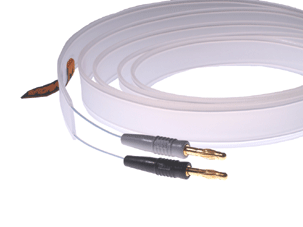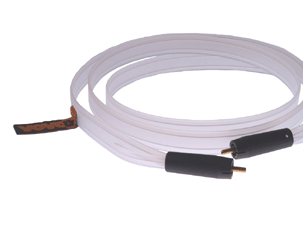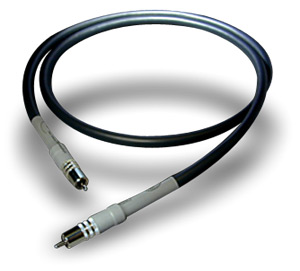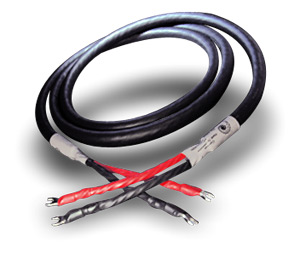第三贴:网络听感1
vovox Initio Direct-通透 细腻 泛音丰富 属于干净透明中性百搭的线
I was recently sent some samples of Vovox Initio speaker cable and single-ended interconnect cable. You may have read Mike Peshkin's recent review of the Vovox Textura cable line here on PFO (see Issue 43 at http://www.positive-feedback.com/Issue43/vovox.htm), but if not, I wouldn't be surprised if this brand is new to you. Though not yet well known in the USA, Vovox manufactures cable for the prosound and recording industry, in addition to their line of audiophile cables.
A Swiss company, Vovox claims that their designs, which utilize solid core silver-plated copper, are based mainly on material science and not electrical engineering. By this, I assume they are referring to what their website calls "unusually large spacing between conductors" (see the pictures of the Initio speaker cable and Initio Direct interconnect).
Electrical engineering tells us that the wider the spacing between the conductors, the higher the inductance and the lower the capacitance. Vovox uses a wide spacing in both interconnects and speaker cables. Again, from the perspective of electrical engineering and based on the differences in voltage, current and impedance requirements of the two cable types and the equipment with which they will interface, it is common practice to make the interconnect as low in capacitance as possible, while making speaker cable as low in inductance as possible. This is done in order to maximize signal transmission within the audio band, without the cable acting as a filter. So, upon first seeing the Initio speaker cables, my eyebrows raised a bit in skepticism. The company claims that this wide spacing helps prevent detrimental magnetic field interaction between the conductors.

Once past my initial reaction, it was obvious upon inspecting these cables that they are manufactured to a consistently high standard. In addition to high quality conductor material, these designs are based on high purity, high tech plastics without plasticizers or color pigments. In their website FAQ, Vovox explains that their approach provides new insights that complement rather than contradict the electrical engineering viewpoint. The Vovox credo… "The clearer the sound that reaches the ear, the more it moves us".
Move Me
I decided to first install the Initio interconnect between my Esoteric DV-50 universal player and the preamp, and then move on to the speaker cables after my initial impressions. These interconnects are terminated with Eichmann Bullet connectors. In my experience, connectors are nearly as important as cables in reproducing a clean signal, and the Eichmann connectors are excellent.
My first musical selection was from the recent Doors box set called Perception (Rhino R2 77645). If you haven't seen or heard this, it is worth checking out. This is a DVD-A set containing each of the six original Doors albums. Each disk contains bonus tracks, and everything here was remastered by Bruce Botnick, the original Doors engineer and producer. There are also separate CD versions of each DVD-A disk, a real convenience and an added value for the set. In this instance, I picked the Morrison Hotel album.

Listening to, among other cuts, "The Spy," I was struck by how smooth and extended the sound was. The DVD-A's higher resolution, especially in the treble, allowed me to hear what the Initio interconnect could do on top. This cable seems very evenhanded in its presentation, neither spotlighting nor obscuring the musical detail. Soundstaging was also well handled, the images being open and dimensional.
Next up, I spun the new (2007) John Fogerty CD, Revival (Fantasy FCD-30001). Cut 2, "Gunslinger," also exhibited some of the same overall characteristics of smooth extended sound. Fogerty's boogie factor was undiminished by the Initio interconnect. I did, however, feel that the bass was a bit lighter than with my standard reference Soundstring cables.
In order to get a better sense of the bass performance I spun the 2000 Steely Dan disc, Two Against Nature (Giant 9 24719-2). This disc has really good punch in the bass and lots of funk factor. The Initio interconnect did a good job of conveying the essence of this music. Dynamics were very good and though I did feel that the bass was less prominent, it wasn't enough so to be of major concern.
Movin' and Groovin'
At this point I added the Initio speaker cable to the system. My first musical selection was the eponymous Keb' Mo', 1994 (Okeh/epic EK 57863). I have several other discs by this artist, but this one is still my favorite. It is well recorded, with a rich intimate sound and excellent soundstage. All the positive things I've mentioned above about the Initio interconnect also apply to the speaker cables, with one interesting exception. The combination of the Initio interconnects and speaker cable completely eliminated my concern over bass performance. Obviously, these cables are intended to work well together, and they do, enhancing all the positive factors for smooth, open and detailed sound.
I played many other discs, including the Ray Charles SACD from 2004, Genius Loves Company (Concord SACD-1033-6); Muddy Waters Folk Singer on CD, originally released in 1964 and reissued by Mobile Fidelity as UDCD 593; Albert King/Stevie Ray Vaughan In Session SACD (STAX SXSA-7501-6); and Sonny Rollins Tenor Madness on SACD, a 2004 reissue of the original 1956 recording on Prestige PRSA-7047-6 with consistently good results.
Conclusions
I reread Mike Peshkin's review of the Vovox Textura cable line and noticed that he had similar things to say about those cables. To quote him, "Extension of highs and air is what this wire seems to excel at." There appears to be a family resemblance, in that the Initio cables could be described in much the same way. I very much enjoyed my time with these cables and found much to like about them. Compared to what you can pay for boutique audiophile cables these days, the Initio line seems reasonably priced and very well made. I predict that Vovox will enjoy a good future in the American marketplace if they keep to their current model.
I would also like to say a special thanks to Vinh Vu, the US distributor for his kindness and patience with me. My review process was somewhat delayed due to illness, and he was quite understanding.
As with any audio product, it is always best to try it in your own system to make sure that it is a synergistic match with your setup, and has a presentation that is to your taste. With that caveat, I can easily recommend these products. Will Wright
AFA: 英国线材品牌,善用合金材料做线基。其信号线旗舰售约2300美金一米,系50%无氧铜和50%的12种材料合金,次旗舰售约800美金一米,系50%无氧铜和50%的10种材料合金。旗舰和次旗舰价格差距如此之大,个人估计是旗舰信号线用上了黄金。未见太多用家,但耳机大家谈的andy01系统的神经线过机线喇叭线均用上了afa silver lance,可见这条线能够毒到人。
Cardas Golden Cross RCA - 味非常浓, 中频厚重, 声慢, 条幼肥大 高频无光
Cardas Audio Golden Reference Interconnects and Speaker Cables
by Marc Mickelson

Cardas Golden Reference interconnect...
| Review Summary | Sound | "Consummate" -- " smooth and detailed, physical in the bass, and not at all warm and rich, as earlier Cardas cables had sounded." "In the end, what defines the sound of Golden Reference interconnects and speaker cables more than anything is their high level of neutrality, real neutrality, not the thin, washed-out sound that audiophiles often think represents neutrality." |
| | Features | For "Golden Reference interconnects, three 26AWG pure-copper conductors are used with Teflon and air dielectrics to produce a cable with a mere 7pF per foot capacitance in balanced configuration, 12pF per foot single-ended." "Each polarity of Golden Reference speaker cable is 3.5AWG due to the use of 816 individual conductors -- 12 bundles of 68 conductors, 408 for each positive and negative leg. This produces a speaker cable whose capacitance is 36.9pF per foot." |
| | Use | "Break-in is very important with Cardas Golden Reference. Out of their baggies, both the interconnects and speaker cables sound anything but musical. There's ample treble glare and hardness that translate into too much edge definition…. It takes, at a minimum, 100 hours of use to eliminate this." |
| | Value | "You can find interconnects and speaker cables that will better them in one specific way or another, but the Golden Reference cables' self-effacing way with music is something that few other cables achieve, and they cost less than most other top-of-the-line competition." |
|
|
|
Cardas Audio has a lot in common with Monty's. It has been around for over 20 years, and during that time George Cardas and staff have created interconnects and speaker cables that always sound good -- if not like the competition. My first brush with Cardas products came in the early '90s with the Hexlink and Quadlink lines. I remember thinking that those cables sounded warm and fuzzy, but also very pleasing -- the cable equivalent of a tube amp that uses 300Bs. I enjoyed those cables but didn't buy them, settling instead for pricier products whose sound caused me to reminisce about the cables from Cardas with added fondness. Such are the whims of audiophiles.
So it was with no small enthusiasm that I asked Cardas Audio about reviewing the company's newest cable line, Golden Reference. I was interested to hear if and how the Cardas sound had evolved, and also determine where the company's cables belonged in terms of the many lines I've heard and written about. Some reviewers consider writing about cables sonic torture. I, on the other hand, enjoy it, perhaps because interconnects and speaker cables are easy to use (putting aside break-in considerations) and I have electronics and speakers that I love. Also, we at SoundStage! haven't written about Cardas Audio products in quite some time, so discussing Golden Reference interconnects and speaker cables seemed like a perfect way to address a few issues with a single review.
By George!
Cardas Audio makes and/or markets an impressive array of products -- from audio cables and connectors to phono cartridges -- all of which come from the fertile mind of George Cardas. Cardas, an audiophile of some renown, holds patents on cable stranding and conductor design, and his Golden Reference line grew out of his involvement in the recording industry, where cable of small diameter, high flexibility, and low capacitance and reactance is prized for its use in the long runs that snake around recording sites.
Golden Reference interconnects and speaker cables feature Cardas' patented Golden Section multi-gauge stranding, which is based on the Golden Ratio, "the mathematical proportion nature uses to shape leaves and sea shells, insects and people, hurricanes and galaxies, and the heart of musical scales and chords." In the case of Golden Reference interconnects, three 26AWG pure-copper conductors are used with Teflon and air dielectrics to produce a cable with a mere 7pF per foot capacitance in balanced configuration, 12pF per foot single-ended. Each polarity of Golden Reference speaker cable is 3.5AWG, due to the use of 816 individual conductors -- 12 bundles of 68 conductors, 408 for each positive and negative leg. This produces a speaker cable whose capacitance is 36.9pF per foot. Internal biwiring and triwiring are options.
 ...and Golden Reference speaker cable
...and Golden Reference speaker cable |
In terms of price, Golden Reference is Cardas Audio's top line. One-meter interconnects cost $917 USD, while eight-foot speaker cables run $2106 per single-wire pair. Pricing, however, is somewhat misleading when talking about Cardas products because cables other than Golden Reference may be better suited for certain systems. Before settling on Golden Reference, therefore, you would be wise to hear Neutral Reference and Golden Cross as well.
Also on the menu
The Golden Reference interconnects and speaker cables I received for review connected a veritable Friday-night buffet of high-resolution components. Speakers were Wilson Audio MAXX 2s, which were driven by Lamm ML2.1 and M1.2 Reference monoblocks. I used three different "Reference" preamps: Lamm L2 Reference, VTL TL-7.5 Reference, and Mark Levinson No.32 Reference. Digital sources were an Esoteric X-01 CD/SACD player, Audio Research CD3 Mk II CD player, and Zanden Audio Model 5000 Mk III DAC, which was used with a Mark Levinson No.37 or the ARC CD3 Mk II as transport. Power was courtesy of Shunyata Research -- Anaconda Vx, Anaconda Alpha and Taipan power cords, and a Hydra Model-8 power conditioner. The BNC-terminated digital link between the Zanden DAC and the transport used was an Audience Au24. The Lamm ML2.1 amps and L2 preamp sat on Silent Running Audio VR 3.0 isoBases, while digital components sat atop Harmonic Resolution Systems M3 platforms or a pair of Michael Green equipment racks.
Break-in is very important with Cardas Golden Reference. Out of their baggies, both the interconnects and speaker cables sound anything but musical. There's ample treble glare and hardness that translate into too much edge definition -- maybe "edginess" describes it best. It takes, at a minimum, 100 hours of use to eliminate this, which is no short amount of time to run an audio system and not listen to it. Luckily, when you're "there," past the ugliness of the break-in period, the cables will let you know with sound that is utterly transformed.
Main course
The last interconnects and speaker cables I reviewed were Siltech Generation 6 Signature Compass Lake and The Emperor, and to say that I was impressed by these very expensive Dutch cables is an orchestra-sized understatement. However, as I listened to the Cardas Golden Reference cables after break-in, I thought that the sound was similarly all-encompassing as that of the Siltech cables, but not quite the equal of their near-golden glow and exceptionally low noise, which manifests itself as abundant detail -- less noise means more signal. Golden Reference sounded smooth and detailed, physical in the bass, and not at all warm and rich, as earlier Cardas cables had been. Some listeners want sound that conveys romance, while others want the sense that no romance exists. I can't say which way the Cardas Golden Reference cables lean, so consummate is their performance.
I have slowly been accumulating Blue Note RVG remastered CDs. These include many important jazz titles whose sound is consistent from recording to recording. The first thing you'll notice is that the level of each recording is a couple of clicks of the volume control above average for CDs. Moreover, the sonic character of these recordings is rather lean, even sterile -- the opposite of the more full sound of JVC XRCDs and especially DCC gold CDs. Golden Reference conveyed this handily, showing Kenny Burrell's Midnight Blue [Blue Note 7243 2 95335] to sound spot-lit and a bit bleached. You might wonder from what I say about RVG remasters why anyone would buy them. They are not as rich and warm as I would like them to sound, but they are still the best way to hear the classic music on them. They are high-resolution recordings that no one will mistake for analog.
In contrast are the many CD and SACD releases from Telarc, whose warmth and fullness are as apparent as the stark whiteness of Blue Note's RVG remasters. Again, the Golden Reference interconnects and speaker cables conveyed this personality trait, but also showed that SACDs such as Sisters & Brothers [Telarc SACD-63588], a blues celebration that features the talents of Eric Bibb, Rory Block and Maria Muldaur, sound terrific. The SACD has a distinctly hear-into character, especially concerning the vocals. Again, conveying this was no problem for Golden Reference, which also gave the recording's warmth a fair shake, including the full, rich bass tones.
Pinning the sound of these cables down is an exercise in futility, except to say that their sound is complete and satisfying. Perhaps the recording that proved this to me more than any other was the Mobile Fidelity SACD of R.L. Burnside's First Recordings [Mobile Fidelity UDSACD 2026]. Set to tape in 1968 on a portable recorder, the songs on First Recordings have the sort of immediacy and spontaneity that makes them sound new every time you hear them. That Mobile Fidelity decided to re-release this gem is notable enough, but MoFi's standard high-resolution remastering job makes playing this SACD one of the things that turns us into audiophiles -- we get very close to this music. If any part of a playback system smears transients or obscures detail, or thins out the presence of Burnside's voice, First Recordings will sound like an older recording of mediocre quality. My system is highly resolving, and this held true while Cardas Golden Reference connected everything, the cables imparting little signature of their own. Consequently, First Recordings sounded spectacular -- intimate, powerful and real.
In the end, what defines the sound of Golden Reference interconnects and speaker cables more than anything is their high level of neutrality, real neutrality, not the thin, washed-out sound that audiophiles often think represents neutrality. Cardas Golden Reference conveys not only all of the weight and density of the performers, but also the space of the recording venue and the fine points of each performance -- the human quality of the music. These cables never tip one way or another far enough for their neutral character to be altered -- or easily identified.
Second helpings
Because of the amount of discussion of audio equipment online as well as the ease with which used products can be obtained, audiophiles nowadays understand well the difference between sound that's different and better. Of course, one person's different may be another's better, but that's a discussion for another article. For me, "better" means more complete, a greater sense that the limitations of reproducing music at home are being addressed. Hence, as I compared other cable lines to Cardas Golden Reference, I discovered that absolutes are hard to come by. One trait may be handled better by the Cardas cables, another by some other brand.
For instance, Nordost Valkyrja (interconnects, $2000 per meter pair; speaker cables, $4600 per eight foot pair) illuminates at low listening levels better, and casts a brighter, more vibrant soundstage than Golden Reference, which counters with a richer presentation that I wouldn't characterize as rich by nature. Analysis Plus Solo Crystal Oval interconnects ($399 per meter pair) and Solo Crystal Oval 8 speaker cables ($870 per eight-foot pair) sound a great deal like Golden Reference, but their presentation is less weighty, which gives the impression that images are less solid and physical. Acoustic Zen Silver Reference II interconnects ($948 per meter pair) and Hologram II speaker cables ($1048 per eight-foot pair) have a similarly all-encompassing sound, and before comparing them to Golden Reference, I would have thought them the equal of the Cardas cables in terms of overall neutrality. However, their sound is, again, lighter and brighter than that of Golden Reference, which doesn't sound dark by any means but seems to cling more faithfully to the idea of absolute neutrality.
What surprised me the most about all of these comparisons was not so much what each different cable told me about the sound of Golden Reference, but what Golden Reference told me about the sound of the other cables. This was due to the fact that the Cardas cables consistently had the least personality. So often audiophiles use cables to tune their systems, but Golden Reference will make this tough going, and may even sound boring to some people's ears. In my system, which is made up of electronics and speakers that are similarly full-range and honest, Golden Reference sounded wonderful.
Good eats
Like a meal at Monty's Blueplate Diner, listening to music with Cardas Golden Reference cables is always satisfying. Throughout their entire performance range, Golden Reference presents a very coherent and complete view of the music, never sounding too much this or too little that, maintaining neutrality at every turn. I especially enjoyed the way these cables conveyed lots of detail while never sounding overtly detailed themselves, imparting a view of the music that was both pristine and tangible. Yes, you can find interconnects and speaker cables that will better them in one specific way or another, but the Golden Reference cables' self-effacing way with music is something that few other cables achieve, and they cost less than most top-of-the-line competition.
One of the joys of eating out is the excitement of trying a new restaurant. Sometimes we're impressed and other times let down, often at a price that we're not happy to have paid. "We should have gone to Monty's" is a phrase I've uttered more than a few times. "I should try some Cardas" looks to be another.
...Marc Mickelson
marc@soundstage.com
下至45楼
[ 本帖最后由 bernie 于 2013-3-1 22:45 编辑 ] |


 |联系我们|有害信息举报:010-60152166 邮箱:zx@jd-bbs.com|手机版|Archiver|黑名单|中国耳机爱好者俱乐部
( 京ICP备09075138号 )
|联系我们|有害信息举报:010-60152166 邮箱:zx@jd-bbs.com|手机版|Archiver|黑名单|中国耳机爱好者俱乐部
( 京ICP备09075138号 )